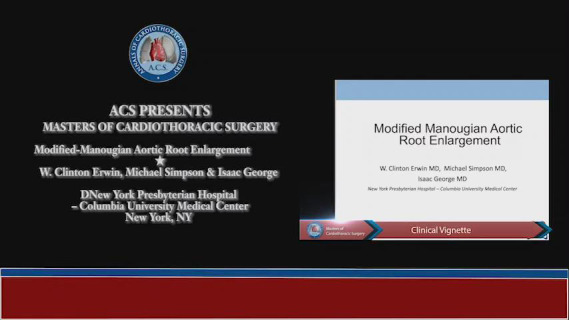Clinical vignette
A 65-year-old male with hypertension, type 2 diabetes, obesity, and non-obstructive coronary disease was referred for severe symptomatic aortic stenosis. The patient’s body surface area (BSA) was 2.3 m2. Pre-operative transthoracic echo (TTE) showed peak aortic gradient of 68 mmHg, mean of 47 mmHg. The patient was scheduled for elective surgical aortic valve replacement.
Surgical technique
Preparation
After induction of anesthesia, intra-operative transesophageal echocardiography (TEE) demonstrated a severely calcified aortic valve, with normal biventricular function.
Exposition
Setup and cannulation
The distal ascending aorta is cannulated, and the right atrium cannulated with a dual stage venous cannula. After commencement of bypass, the aorta is cross-clamped and antegrade Del Nido cardioplegia is given. A right superior pulmonary vein vent is placed to maintain a dry field for the aortic valve replacement.
Aortic valve evaluation and annulus root sizing
An oblique aortotomy is made towards the non-coronary sinus. The valve was noted to be bicuspid with left-right leaflet fusion, and heavily calcified. After inspection, the leaflets were resected, and the annulus debrided. The aortic annulus was sized, first with a 23 mm then 25 mm valve sizer. There was notable difficulty in passing a 25 mm sizer. A minimum of 25 mm valve was considered to be appropriate for the patient to avoid patient-prosthesis mismatch (PPM).
Aortic root enlargement
The aortotomy was extended down the left-non commissure to beyond the level of the annulus. A bovine pericardial patch was then measured and trimmed to the appropriate size, leaving the end of the patch, used to close the aortotomy, long in order to have plenty of patch to close the aorta later. The patch was sewn into the enlarged root with two layers of 4-0 running suture to ensure hemostasis.
Valve replacement
The valve is sized and a 25 mm sizer fits easily into the enlarged root. The level of the valve sizer along the patch is marked with a marking pen to approximate the level of the valve stitches in the patch. Next, 2-0 interrupted mattress sutures (without pledgets) are placed around the aortic annulus. At the transition zones from the native annulus to the patch, one arm of the mattress suture is placed in native aortic tissue, and one arm onto the patch. The valve sutures are then passed through the sewing cuff of a 25 mm valve (Inspiris, Edwards, Irvine, CA, USA). The sutures along the patch are hand tied and the sutures around the remaining annulus are tied with Cor-Knots—our standard practice.
Completion
The root patch is then closed in two running layers along each side, to ensure excellent hemostasis. The cross-clamp is removed and with the patch pressurized. The entire suture line is checked for hemostasis before weaning from bypass. TEE demonstrated excellent valve hemodynamics (mean gradient 9 mmHg) with no paravalvular leak.
Follow up
The patient was discharged home on post-operative day five and was seen in clinic six weeks post-operatively, at which time he was back to his normal activities including walking one mile per day.
Comments
Manougian first described his patch root enlargement technique in 1979 (1), and it has continued to be a valuable technique for preventing patient prosthesis mismatch, a recognized concern with aortic valve replacement as early as 1970 (2). The modified-Manougian procedure follows these same operative steps, with less risk of mitral valve compromise as the modified Manougian does not extend all the way down to the anterior mitral leaflet. Of the well described root enlargement techniques, the modified-Manougian is easily reproducible by following a few technical pearls, namely:
The enlargement incision must be made deep enough past the aortic annulus to ensure adequate enlargement of at least 1–2 valve sizes, yet not deep enough to damage the anterior leaflet of the mitral valve.
Do not make the angle of the fashioned patch too acute and leave plenty of patch to accommodate the area that will be inherently lost by the suture lines.
Two rows of patch sutures are helpful in hemostasis and pulling/tightening the suture line with an instrument such as a nerve hook can prevent most bleeding of the root patch. If there is a concern for a gap, it is prudent to take a preemptive mattress repair suture from inside out to close the gap.
When taking bites onto native aortic tissue, make sure to take bites of adequate depth such that the aorta is not prone to tear.
One major downside and complication of the Manougian and even modified-Manougian is the potential for mitral valve regurgitation if the patch is extended too far down onto the anterior mitral leaflet. In this scenario, the patch must completely close the mitral defect, altering the mitral geometry as minimally as possible.
In summary, although root enlargement with the modified-Manougian adds surgical risk, it provides for better valve hemodynamics, as well as a larger annular size for future potential transcatheter valve options (3).
Video.

Modified-Manougian aortic root enlargement.
Acknowledgments
Funding: None.
Footnotes
Conflicts of Interest: The authors have no conflicts of interest to declare.
References
- 1.Manouguian S, Seybold-Epting W. Patch enlargement of the aortic valve ring by extending the aortic incision into the anterior mitral leaflet. New operative technique. J Thorac Cardiovasc Surg 1979;78:402-12. [PubMed] [Google Scholar]
- 2.Nicks R, Cartmill T, Bernstein L. Hypoplasia of the aortic root. The problem of aortic valve replacement. Thorax 1970;25:339-46. 10.1136/thx.25.3.339 [DOI] [PMC free article] [PubMed] [Google Scholar]
- 3.Hawkins RB, Beller JP, Mehaffey JH, et al. Incremental Risk of Annular Enlargement: A Multi-Institutional Cohort Study. Ann Thorac Surg 2019;108:1752-9. 10.1016/j.athoracsur.2019.04.118 [DOI] [PubMed] [Google Scholar]


